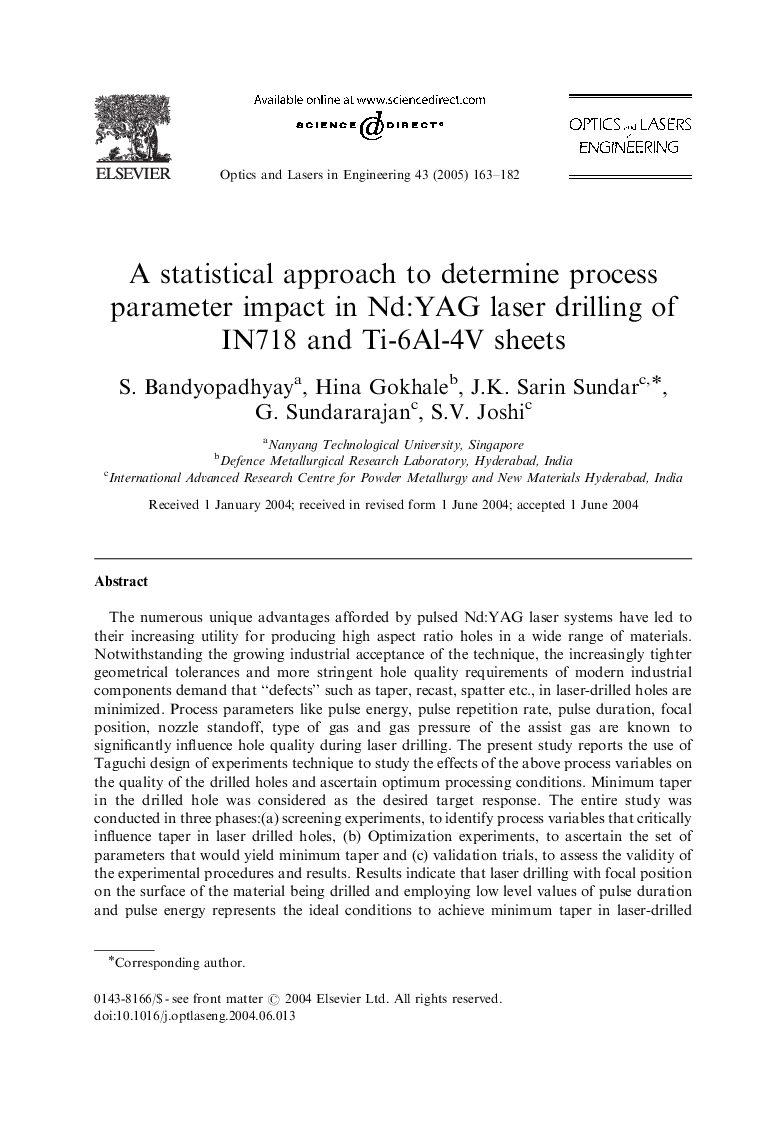| کد مقاله | کد نشریه | سال انتشار | مقاله انگلیسی | نسخه تمام متن |
|---|---|---|---|---|
| 10408925 | 893748 | 2005 | 20 صفحه PDF | دانلود رایگان |
عنوان انگلیسی مقاله ISI
A statistical approach to determine process parameter impact in Nd:YAG laser drilling of IN718 and Ti-6Al-4V sheets
دانلود مقاله + سفارش ترجمه
دانلود مقاله ISI انگلیسی
رایگان برای ایرانیان
کلمات کلیدی
موضوعات مرتبط
مهندسی و علوم پایه
سایر رشته های مهندسی
مهندسی برق و الکترونیک
پیش نمایش صفحه اول مقاله

چکیده انگلیسی
The numerous unique advantages afforded by pulsed Nd:YAG laser systems have led to their increasing utility for producing high aspect ratio holes in a wide range of materials. Notwithstanding the growing industrial acceptance of the technique, the increasingly tighter geometrical tolerances and more stringent hole quality requirements of modern industrial components demand that “defects” such as taper, recast, spatter etc., in laser-drilled holes are minimized. Process parameters like pulse energy, pulse repetition rate, pulse duration, focal position, nozzle standoff, type of gas and gas pressure of the assist gas are known to significantly influence hole quality during laser drilling. The present study reports the use of Taguchi design of experiments technique to study the effects of the above process variables on the quality of the drilled holes and ascertain optimum processing conditions. Minimum taper in the drilled hole was considered as the desired target response. The entire study was conducted in three phases:(a) screening experiments, to identify process variables that critically influence taper in laser drilled holes, (b) Optimization experiments, to ascertain the set of parameters that would yield minimum taper and (c) validation trials, to assess the validity of the experimental procedures and results. Results indicate that laser drilling with focal position on the surface of the material being drilled and employing low level values of pulse duration and pulse energy represents the ideal conditions to achieve minimum taper in laser-drilled holes. Thorough assessment of results also reveals that the laser-drilling process, optimized considering taper in the drilled hole as the target response, leads to very significant improvements in respect of other hole quality attributes of interest such as spatter and recast as well.
ناشر
Database: Elsevier - ScienceDirect (ساینس دایرکت)
Journal: Optics and Lasers in Engineering - Volume 43, Issue 2, February 2005, Pages 163-182
Journal: Optics and Lasers in Engineering - Volume 43, Issue 2, February 2005, Pages 163-182
نویسندگان
S. Bandyopadhyay, Hina Gokhale, J.K. Sarin Sundar, G. Sundararajan, S.V. Joshi,